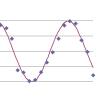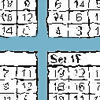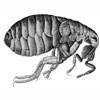Skip over navigation



Or search by topic
Number and algebra
Geometry and measure
Probability and statistics
Working mathematically
Advanced mathematics
For younger learners
Core Scientific Mathematics
Age 14 to 18
Challenge Level 





 |
 |
 |
Welcome to the Core Scientific Mathematics section of stemNRICH - Core. This contains a set of activities designed to develop the basic applied mathematical skills needed to make the most of the study of a science in the final years of school or university.
| For more advanced mathematical problems please see the Advanced Scientific Mathematics section. For advanced activities more directly based around specific mathematical applications, please see bioNRICH , chemNRICH , physNRICH or engNRICH | ||||
| Area of maths | Style | Teacher Notes | Question | Description |
|---|---|---|---|---|
| Numbers | YES | Big and Small Numbers in Biology | 10 individual questions using numbers big and small to calculate or estimate various quantities in simple biological contexts. | |
| YES | Big and Small Numbers in Physics | 10 individual questions using numbers big and small to calculate or estimate various quantities in simple contexts relevant to physics. | ||
| - | Constantly Changing | Many physical constants are only known to a certain accuracy. Explore the numerical error bounds in the mass of water and its constituents. | ||
| YES | Peaches Today, Peaches Tomorrow | A little monkey had 60 peaches. On the first day he kept 3/4 of his peaches, gave the rest away and then ate one. On the second day he kept 7/11 .... How many did he have left at the end? | ||
| See also, in particular, the Dilution and Proportional Reasoning problems on the chemNRICH pages | ||||
| Algebra, equations and graphs | YES | Temperature | Is there a temperature at which Celsius and Fahrenheit readings are the same on a thermometer? | |
| YES | What's that graph? | Which graphs, equations and physical processes go together? | ||
| . | . | . | . | |
| Geometry and symmetry | |
YES | How Far Does it Move? | Experiment with the interactivity of "rolling" regular polygons, and explore how the different positions of the red dot affects the distance it travels at each stage. |
| YES | Semi-regular tessellations | Explore ways to symmetrically tile the plane with this beautiful interactivity. | ||
| YES | Efficient Packing | How will you go about calculation to pack small circles into a large square? | ||
| - | Ball Bearings | If a is the radius of the axle, b the radius of each ball-bearing, and c the radius of the hub, why does the number of ball bearings n determine the ratio c/a? Find a formula for c/a in terms of n. | ||
| Curve fitting and sketching | YES | Fill me up | Imagine these flasks filling with water. How would the height of water vary over time? | |
| YES | Real-life Equations | Relate these commonly used equations to points on a series of graphs. Which are possible and which are not? | ||
| YES | Equation Matcher | A series of graphs are given containing just 2 or 3 points. Which equations do the points rule out? | ||
| YES | Maths Filler | Can you work out how to make height-time charts as these unusually shaped vessels are filled up? | ||
| YES | Curve Match | Can you match these curves to the graphs? | ||
| YES | Fill me up too | Analyse the volume of some commonly used scientific vessels. | ||
| Approximations and estimations | YES | Place your orders | Can you sort these quantities into order of size? | |
| YES | Approximately Certain | Estimate these curious quantities sufficiently accurately that you can rank them in order of size. | ||
| - | Global Warming | How much energy has gone into warming up the planet? | ||
| YES | Carbon Footprints | Is it really greener to go on the bus, or to buy locally produced food? | ||
| Powers and roots | YES | A Question of Scale | This interactive page allows you to test your knowledge and skill using powers of 10 to place physical quantities in order of size. | |
| YES | Power Countdown | Try to hit the targets using the operations of powers and roots. | ||
| Data handling | YES | Data Matching | Use your skill and judgement to match the sets of random data | |
| YES | Back Fitter | 10 graphs are of noisy experimental data are given. Can you use the spreadsheet provided to find algebraic graphs which match them closely? | ||
| YES | Who's the best? | Which countries have the most naturally athletic populations? | ||
| YES | David and Goliath | It is suggested that heavier competitors are at an advantage in the shot put. Do the data support that claim? | ||
| YES | Guessing the graph | Analyses these pieces of scientifc data and try to deduce the equation of the curve underlying the process. | ||
| Trigonometry | - | Far Horizon | An observer is on top of a lighthouse. How far from the foot of the lighthouse is the horizon that the observer can see? | |
| YES | Perfect Eclipse | Find out why perfect eclipses are, in fact, perfect. | ||
| Units | YES | Uniform Units | Can you choose your units so that a cube has the same numerical value for it volume, surface area and total edge length? | |
| - | Bigger or Smaller? | Develop your intuition for changing units by asking the simple question: will a unit change give me a larger or smaller number? | ||
| YES | Choose Your Units | Which would be the most sensible units in which to measure these objects? | ||
| Algorithms and decision making | - | How would you score it? | How would you devise a scoring system to score a 'guess the weight' competition? | |
| . | . | . | . | |
You may also like
A Method of Defining Coefficients in the Equations of Chemical Reactions
A simple method of defining the coefficients in the equations of chemical reactions with the help of a system of linear algebraic equations.
Mathematical Issues for Chemists
A brief outline of the mathematical issues faced by chemistry students.
Reaction Rates
Explore the possibilities for reaction rates versus concentrations with this non-linear differential equation




